The Ultimate Guide to Different Types of Email Marketing Campaigns
Email marketing is an incredibly important channel to master for any DTC e-commerce business. In fact, with the right approach, email marketing can contribute to a whopping 20-30% of your revenue. It’s a great way to retain customers, drive conversions,...
Tags
Tools
Level
Related Partners

Email marketing is an incredibly important channel to master for any DTC e-commerce business. In fact, with the right approach, email marketing can contribute to a whopping 20-30% of your revenue. It’s a great way to retain customers, drive conversions, increase repeat purchase rates, elevate customer lifetime value (LTV), get more customers hooked on subscription products and encourage them to splurge on higher average order values (AOV). But it can feel overwhelming with all of the different types of emails, from email campaigns to automated email flows, that you should have.=
If you’re new to email marketing —we’ve got your back with this ultimate guide to the different types of emails. By the end of this post, you’ll be ready to create a solid email marketing strategy to get your e-commerce store generating $5M, $10M and even $20M+ in revenue.
Get a custom-built email marketing strategy with a 14-day free trial of Backbone.
Use Backbone to plan out your email marketing calendar with different types of campaigns, flows, promotions & product launches. With over 5000+ unique campaign ideas & 250+ unique flows, everything is customized for your business!
Types of Emails
Now, let’s dive into the most different types of emails that every DTC e-commerce brand should have in their email marketing strategy.
Welcome Emails
Type: Flow
What are welcome emails?
Welcome emails are the first point of contact between your brand and a new subscriber. Your welcome emails are part of your Welcome Flow which typically has 3-5 emails & the main purpose is to turn leads into paying customers. The Welcome Flow gets non-purchasers to make their first purchase within the shortest time possible by introducing customers to the brand & product.
Why are welcome emails important?
A welcome email establishes your brand relationship with potential customers & guides them to making their first purchase. A strong welcome email can grow your DTC e-commerce business by:
- Converts more email subscribers into paying customers (which means more revenue!)
- Key Metric To Watch: Non-purchaser conversion rate
- Getting potential customers to make their first purchase faster (ie. the amount of time it takes someone to go from being aware of the brand to becoming a customer)
- Key Metric To Watch: Time to first conversion
- Getting more revenue out of each lead you drive to your website (which means lower CPAs & more value from your website traffic)
- Key Metric To Watch: $/lead
Best practices for creating a welcome email:
- Address reasons why someone may be hesitant to buy (ie. it’s too expensive, they don’t understand the product, they’re worried it won’t work)
- Educate customers on your brand’s mission, story & the products you sell.
- Recommend products they might like
- Show the features & benefits of your products & how your product/brand can solve their pain points
- Share social proof of people who benefitted from your product
- Share content that will help or entertain them to provide value & build a brand relationship
- Remove purchase friction (eg. welcome discount, satisfaction guarantees)
Most e-commerce brands also provide a Welcome Offer for new subscribers in their welcome email (typically 10-15% off their first purchase).
Promotional Emails
Type: Campaign
What are promotional emails?
Promotional emails are a type of email marketing campaign that showcase your products with special offers or discounts. They are designed to drive sales through urgency & incentivizing customers with savings. Promotional emails are great for driving additional revenue, but if you send them too often they can become less effective & turn away existing customers from purchasing at full price because they’re “waiting for the sale”. So don’t shy away from promotional emails but don’t overuse them either!
Examples of types of promotional emails you should send:
- Major holidays (eg. 4th of July, Black Friday/Cyber Monday, Labor Day)
- Relevant holidays for your brand (eg. Valentine’s Day, Mother’s Day, St. Patrick’s Day)
- Incentivize subscriptions (eg. 20% off your first month’s subscription)
- Flash sales for specific products or collections (great for clearing out inventory or driving more awareness to new products)
Tips for creating effective promotional emails:
- Keep customers engaged with a clear headline on what the offer is, when it ends & how to claim the offer (eg. discount code)
- Use bold imagery or typography in your headers to grab attention
- Leverage scarcity or urgency such as a limited number of products available or an end date to the promotion
- Remind customers why they should purchase your products
- Have content educating customers on what product they should buy
Newsletter Emails
Type: Campaign
What are newsletter emails?
Newsletter emails are typically a weekly or monthly recurring email sent at the same time & day. A weekly newsletter is often used by DTC e-commerce brands to regularly engage with email subscribers by sharing relevant content or updates on topics that their target audience cares about.
How to create a successful newsletter email
- Be Relevant: When starting a newsletter, think about what your target audience cares enough about that they would be excited to read about each week. For example, a skin care company may send a weekly newsletter sharing tips about skin care & wellness content. A common mistake is using your weekly newsletter to cover only topics YOU care about – like business updates & wins, that may not be relevant information for your customers.
- Be Consistent: Once you’ve committed to a regular schedule for your newsletter, whether it’s weekly, bi-weekly, monthly, or quarterly – stick to it! It’s an important part of building trust with your customers. Don’t start a newsletter if you’re not sure you’ll have the resources to commit to keeping it up.
- Test, Test, Test! Your newsletter can evolve over time. Monitor click through rates to adjust the type & style of content you share in your emails. Monitor open rates to adjust your subject line to keep customers engaged. You can even test adding recommended products in your newsletter to boost sales.
Best practices for designing a newsletter email
- Optimize for clicks & conversions. Most brands make the mistake of ONLY delivering value or sharing content in newsletter emails. That’s great, but ultimately you want to drive revenue & traffic to your site. Make sure to add in CTAs to your content to drive them back to your site, or even just sharing “hooks” of blog posts to get them on your site to read the rest.
- Have strong headlines. With so much content in one email, make it easy for your readers to find the content most relevant to them & skim the email for the main points. Use clear headlines & short summaries of the most important information to help readers navigate which part of the newsletter they want to read
Abandoned Cart Emails
Type: Flow
What are abandoned cart emails?
Abandoned cart emails remind customers about items they left in their shopping carts and encourage them to complete their purchases. Abandoned Cart emails are sent out of an Abandoned Cart Flow which typically has 2-4 emails in it. The goal is to get customers who started checkout but abandoned the checkout process (ie. didn’t complete checkout) to complete their purchase.
How to create an effective abandoned cart email
- Send a timely reminder: Timing is crucial for abandoned cart emails. Send the first email within 4 hours after cart abandonment, followed by a series of 2-3 more emails over the next few days to keep the customer engaged.
- Personalize the email with their products in cart: Include images of the abandoned items in their cart to remind customers what they left behind and make the email more visually appealing.
- Offer an incentive, like a discount or free shipping: Incentivize customers to complete their purchases by providing a limited-time offer, such as a discount code or free shipping. This is typically used in emails #3-4 of the Abandoned Cart Flow to drive urgency
- Use testimonials & reviews: Build trust in your product & brand with short testimonials from customers about the quality, the results they saw, or what they loved most. UGC images to give customers ideas on how to use the product also often work well.
Examples of abandoned cart emails that work
Better Brand: The bold header along with the “Free Shipping” incentive makes a strong call to action for shoppers to return & make the purchase. The product image along with the direct link to their cart is also optimized to increase click through rates.

On: The On team included a clear, bold image of the product that the shopper left in their cart above the fold which means that users will see the image even without scrolling. The added product recommendations & other collections to shop is also a great email strategy to increase click through rates and average order value (AOV)

Whiskey Loot: Whiskey Loot created a custom segmented Abandoned Cart email specifically for shoppers who abandoned purchasing a subscription. The customization allows this email to provide the most relevant information for their specific product. The email also does a great job of of sharing key information on what makes Whiskey Loot’s subscription unique to increase conversions.
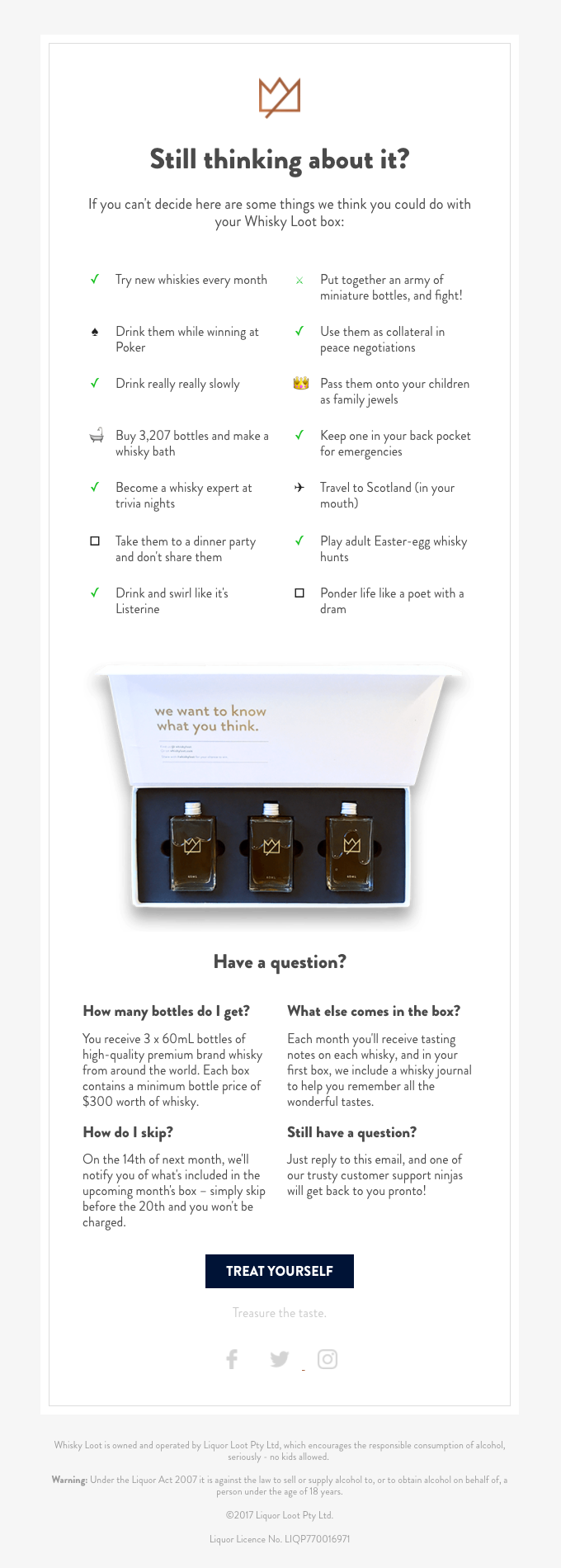
Casper: Sometimes, the simpler the better! Casper’s email has a great headline & clear call-to-action buttons to return to their cart. They keep it short & sweet with a product image of their cart and include a short testimonial to build additional trust & authority.
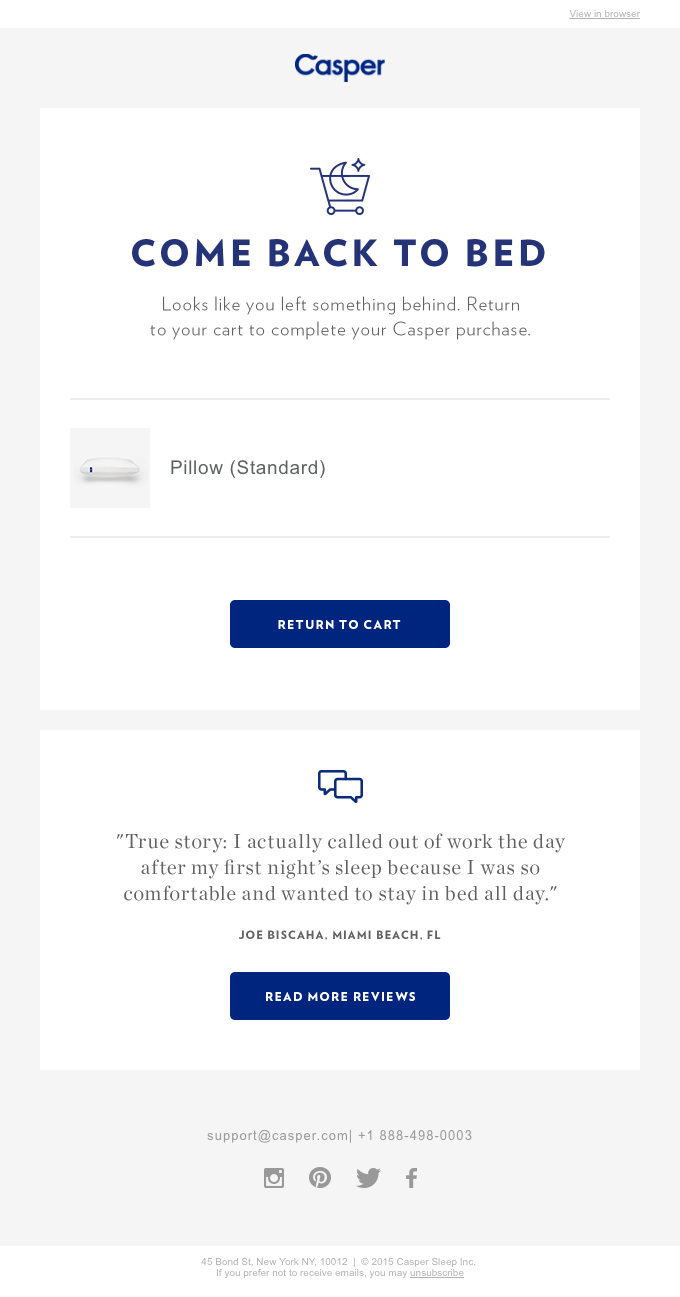
Transactional Emails
Type: Flow
What are transactional emails?
Transactional emails are triggered by specific customer actions that are related to their purchase or account, and provide important information or confirmations. The most common types of transactional emails for DTC e-commerce brands are Order Confirmations & Shipping Notifications.
How to use transactional emails to boost engagement
- Make it easy for customers to get the key information: Typically this includes a summary of their order
- Leverage your transactional emails for additional sales through upsells or cross-sells: Suggest additional products or services that complement the customer’s recent purchase or activity to increase AOV & drive sales.
- Build brand loyalty with additional CTAs: Invite customers to explore more of your of your store, check out your latest blog post, or follow you on social media. This can help maintain their engagement with your brand.
- Incorporate loyalty & referral programs: If you have a loyalty program, show customers how many points they could earn from their purchase & share the perks of being part of the program. Also share referral perks & their unique referral link!
Examples of effective transactional emails you can send
Crocs: This order confirmation emails does a great job of showing the customer where they’re at in the journey of receiving their order & what to expect next. The added contact info helps provide an exceptional customer experience as well.

Huckberry: This order confirmation email provides a clear summary of the customer’s order along with key information to on refunds & reaching out for customer service. The additional product recommendations can help get more repeat customers by encouraging them to make a next purchase.

Maude: This email by Maude is sent after a customer places an order to promote their referral program as well as encouraging customers to follow them on social media.
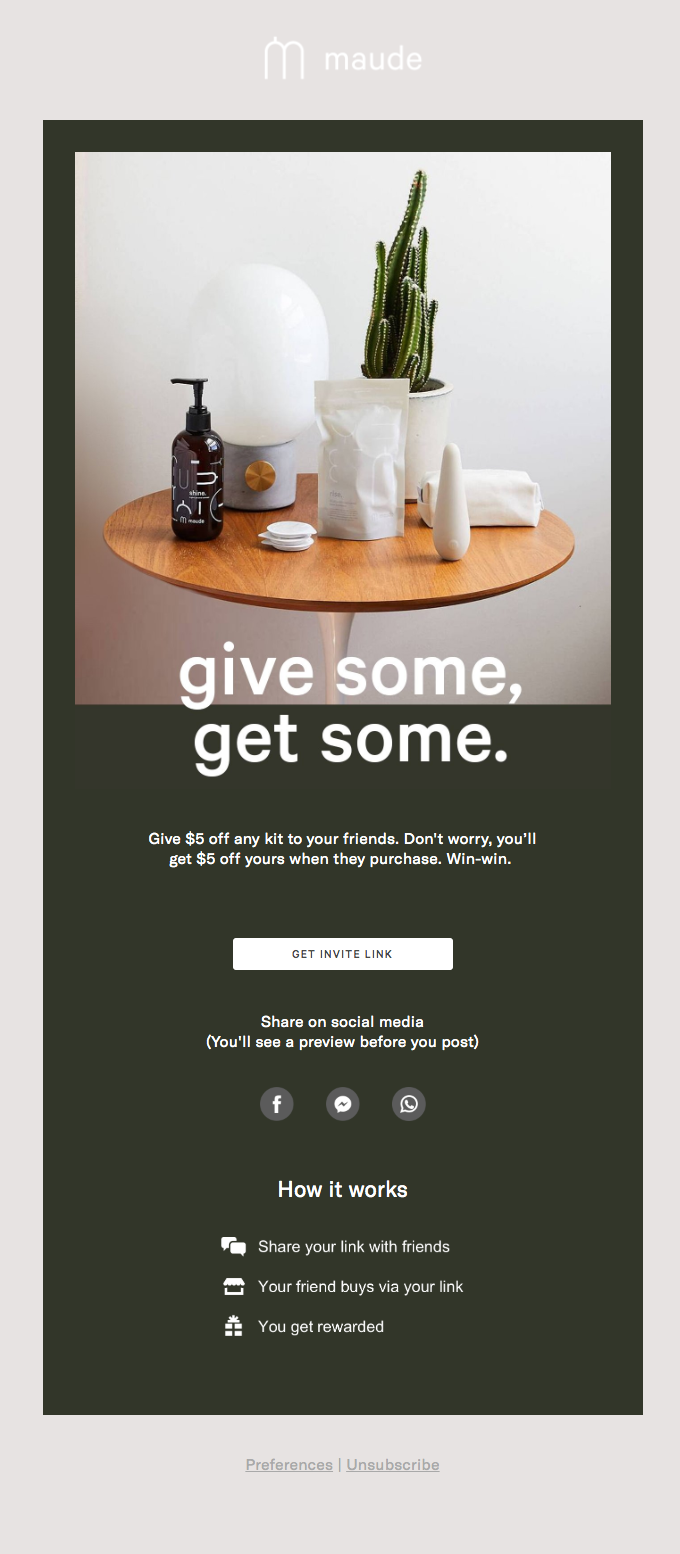
Re-Engagement Emails
Type: Campaign
What are re-engagement emails?
Re-engagement emails target inactive email subscribers & customers with the goal of well, re-engaging their interest in your brand and prompting them to make a purchase.
How to create a successful re-engagement email campaign
- Segment your subscribers & your purchasers: Separate your re-engagement email marketing campaign for inactive email subscribers (who have never made a purchase) & existing customers.
- Segment subscribers & purchasers based on time frame: Identify subscribers/customers who haven’t opened, clicked, or made a purchase within a certain period (e.g., 3 months, 6 months, 9 months) & create tailored re-engagement campaigns for each audience.
- Offer a compelling incentive to return: Provide a reason for inactive subscribers/customers to re-engage with your brand, such as an exclusive discount, a limited-time offer, or access to a new product/collection.
- Test different subject lines and content: Create a hypotheses on why subscribers/customers would have stopped engaging (eg. content isn’t relevant, didn’t find a product they liked, didn’t get the benefit out of their purchase) & experiment with various subject lines, headlines, and messaging.
Tips for designing an effective re-engagement email
- Use an intriguing subject line: Think about what might catch their attention as they’re scrolling through their inbox. A casual subject line? A bold, compelling offer?
- Include a bold header with the main hook of why they should re-engage: Capture the attention of your subscribers with engaging images that showcase your brand and products in a fresh, exciting way along with the main reason why they should re-engage with you now.
- Include a clear CTA: Guide subscribers toward the desired action, whether it’s visiting your website, browsing a specific product category, or redeeming a special offer. Make sure your CTA is prominent & that there’s at least one CTA button above the fold.
Social Media Emails
Type: Campaign
What are social media emails?
Social media emails are a fantastic approach to mixing up your email calendar with different types of emails. They promote your brand’s social media presence and encourage subscribers to follow and engage with you on various platforms & can also be used to promote content from your social media accounts to drive sales.
How to use social media emails to boost engagement
- Highlight the benefits of following your brand: Explain what subscribers can gain by following your social media channels, such as exclusive deals, early access to new products, or valuable tips and insights.
- Leverage your social media comments & UGC posts: Send emails of positive product reviews in Instagram & TikTok comments, or content from your customers that you’re tagged in to drive sales.
- Showcase your best content: Share examples of your most popular or engaging social media posts to give subscribers a taste of what they can expect from your brand on those platforms.
- Include social sharing buttons: Make it easy for subscribers to follow, like, or share your content by incorporating social media buttons or icons directly in the email.
Examples of effective social media emails
- Send Social UGC & Testimonial Emails: Feature images or posts from your customers using your products to showcase real-life experiences and create a sense of community.
- Launch Polls: Get subscribers excited about specific channels by launching unique polls or surveys on social media only. For example, using an IG story poll to survey what the newest color for a product should be.
- Announce social media contests or giveaways: Encourage email subscribers to participate in your social media contests, events, or giveaways, which can help boost engagement and drive traffic to your social channels.
- Leverage influencer partnerships: If you collaborate with influencers or brand ambassadors, showcase their content in your social media emails to build credibility and demonstrate social proof.
Milestone Emails
Type: Campaign or Flow
What are milestone emails?
Milestone emails celebrate significant events, achievements, or anniversaries related to your customers or your brand. These anniversary emails can help strengthen your relationship with customers and make them feel valued.
How to use milestone emails to connect with your customers
- Celebrate key dates: The most common milestones for DTC e-commerce customers include 6-month or 1-year anniversaries from when they joined your list or made a first purchase. Or if you collect customers’ birthdays, give them a special birthday present!
- Personalize the celebration: Use customer data to create personalized milestone emails, such as the first day they made a purchase from you or how many points they’ve collected from your loyalty program.
- Offer incentives or rewards: Give customers a reason to celebrate & show how much you value them by offering exclusive discounts, freebies, or other special offers tied to the milestone. You can also use this as a chance to introduce repeat customers to new products they haven’t tried.
- Celebrate your brand’s milestones: Keep customers informed about your brand’s accomplishments, such as reaching a certain number of followers, expanding to new locations, hitting sales targets, or celebrating company anniversaries.
Examples of effective milestone emails
FitBit: This email is an example of making marketing emails feel personal to each subscriber. FitBit pulls in the milestones of the user with their individual statistics & accomplishments.
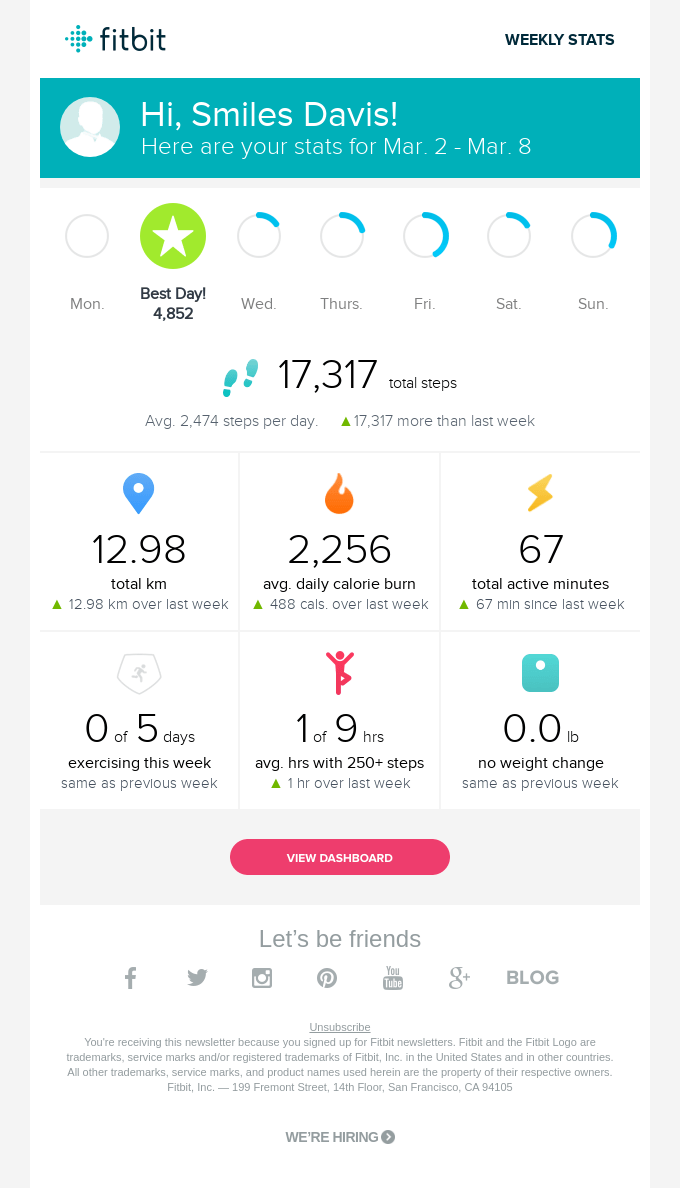
Teachable: This email by Teachable celebrates a key milestone for the brand to celebrate alongside its customers, while driving more awareness to their product.
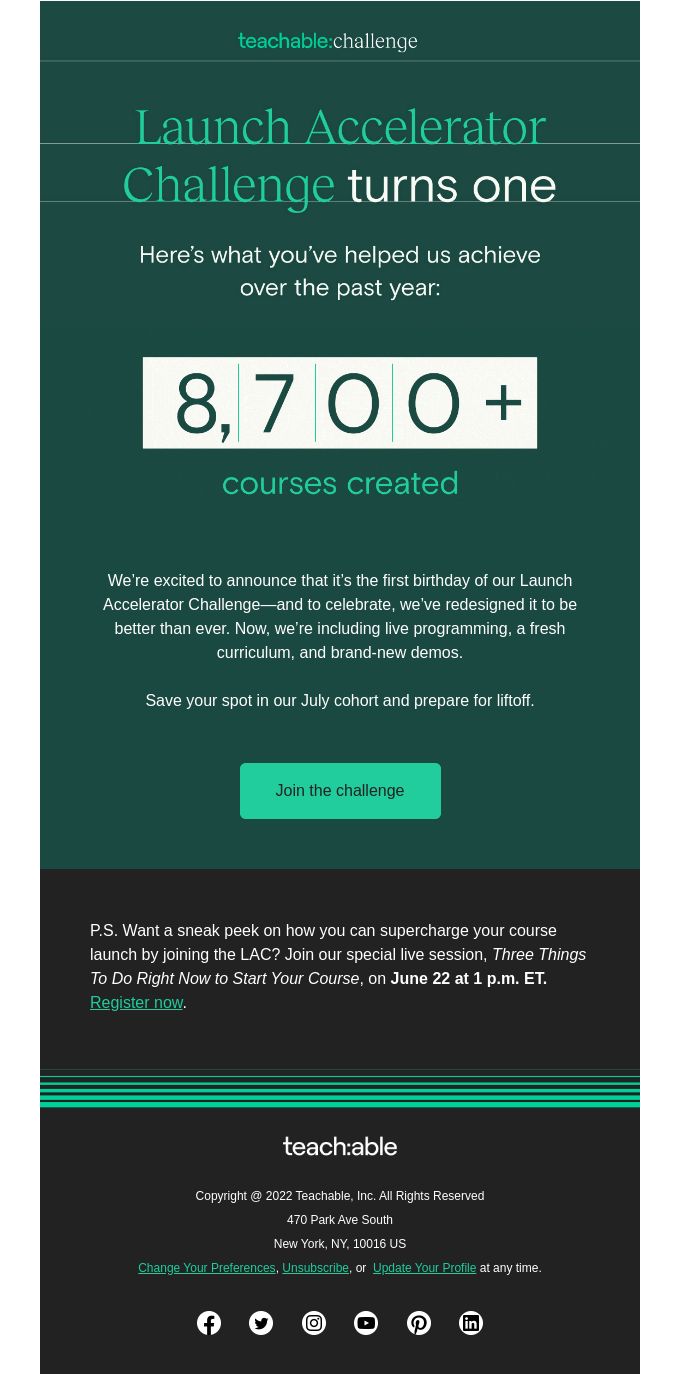
MacPaw: This birthday email by MacPaw takes a playful approach to making a marketing email more engaging while also being a promotional email to drive future purchases.

Survey Emails
Type: Campaign or Flow
What are survey emails?
Survey emails invite customers to share their opinions, feedback, or experiences related to your brand, products, or services. They not only help you gather valuable insights and improve your offerings, but give a chance to make your email subscribers and customers feel more involved in your business.
How to create an effective survey email
- Leverage embedded engagement buttons: These are built-in buttons in the email that a customer can click directly from the email to improve the survey completion rate & boosts your click through rates. This is an example from Longplay for a fitness app to collect key information from customers on their fitness level to customize content & sales emails.
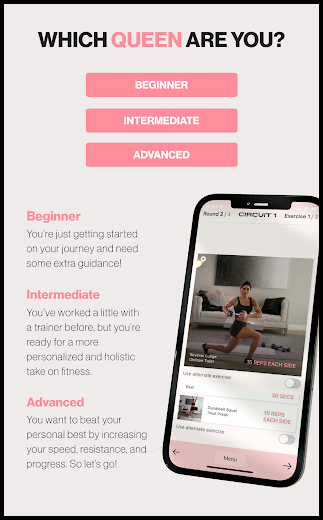
- Define the survey’s purpose: Clearly explain the goal of the survey and how customers’ feedback will be used to make improvements.
- Keep it short and focused: Limit the number of questions and focus on the most important topics to increase response rates.
- Offer an incentive: Encourage participation by offering rewards, such as discounts, gift cards, or entries into a giveaway.
Tips for designing a successful survey email
- Make It Easy: You want to build an exceptional customer experience & make it easy for customers to complete the survey — especially if you’re sending them to a different page, like Typeform, to collect survey responses.
- Tell Them How Long The Survey Will Take: Set expectations with the customer by telling them that the survey will only take a few minutes. You want to keep surveys short for customers to complete, ideally < 2-3 3 minutes.
- Include a prominent CTA: Make it easy for customers to access the survey with a clearly visible and clickable button or link.
- Show appreciation: Thank customers for their time and feedback, emphasizing the value of their input & sharing a thank you offer such as a discount or free gift.
Educational Emails
Type: Campaign or Flow
What are educational emails?
Educational emails provide valuable information, tips, or insights related to your products & brand. These marketing emails are a great way to showcase your product, how it’s different from alternate options, and how to use your product. They may also include additional blog content to provide more value and drive customers to your website.
How to create educational emails that engage your audience
- Identify relevant topics: The most important part of effective educational emails is writing content that your audience is excited about and/or has a pain point around. Start by asking what questions your customers might have about your product or what information they would need to make a purchase decision.
- Use storytelling and visuals: Valuable information is great but how it’s presented makes it interesting. Incorporate storytelling strategies, typography & infographics to convey the information in a way that makes it easy for customers to understand.
- Provide actionable advice: Share practical tips, how-tos, or step-by-step guides that customers can apply to their own lives.
- Incorporate seasonality: Your customers likely care about different things or have different pain points at different times of the year. For example, a dog food brand might share tips on how to protect your dog’s fur in the winter & tips to travel with your dog in the summer.
Backbone‘s campaign database has over 5000+ different types of campaign emails including educational emails. Try out Backbone today to generate new campaign ideas & create emails that convert.
Examples of effective educational emails
Kion x Brute Force: This email designed by our team at Longplay for Brute Force (a fitness training equipment company) and Kion (a supplement company) educates customers on a common pain point which is how to maximize their workout by taking the right supplements.

No Ordinary Moments: This email by No Ordinary Moments educates customers on what makes the mushrooms different & higher quality, while also educating them on how to use their products for different benefits.

Ritual: This email by Ritual, a supplement company, educates customers on the design & formulation of their unique supplements to build trust in their brand & drive sales.

Advanced Email Marketing Strategies
Segmentation
What is segmentation?
Segmentation is the process of dividing your email list into smaller, more targeted groups based on specific criteria, such as customer characteristics or behaviors, then sending different types of emails for different audiences. Common types of segmentation that is used by a DTC ecommerce store to create different audiences are: location, # of purchases, types of products purchased & email engagement. Unlike personalization, segmentation is choosing what emails a customer receives based on their profile/behaviour.
Why is segmentation important?
Segmentation allows you to send different types of emails with tailored content that resonates with each group, leading to increased engagement, higher open and click-through rates, and improved conversion rates. For example, an email subscriber who has never made a purchase may need different types of offers & incentives, compared to repeat customers.
How to segment your email list for better results
- Analyze customer data, such as demographics, purchase history, and email engagement.
- Think about what the main 2-4 customer groups your DTC ecommerce store has that may need different types of emails. Some common ways to segment your audience are:
- Engaged vs Unengaged email subscribers
- Purchasers vs Non-Purchasers
- Types Of Products Purchased
- Create these segments in your ESP based on relevant criteria, such as new subscribers, high-value customers, or inactive subscribers.
- Think about the different messaging, content or incentives that each customer group may need to make a purchase.
- Develop targeted email campaigns for each segment & send them separately to track the data.
Personalization
What is personalization?
Personalization involves customizing email content based on individual customer profiles or behaviors to make the message more relevant and engaging. Unlike segmentation, personalization is choosing what a customer sees in the email based on their characteristics & behaviour.
Why is personalization important?
Personalization can increase engagement, improve click rates, drive more sales and build loyalty. This is generally used to personalize recommendations & content based on the products a customer has purchased and the status of a customer. For example:
- Feature only products the customer has never bought (eg. Try It! module)
- Feature only products the customer has already tried (eg. Buy It Again! module)
- Feature scents of other products the customer has already tried (eg. Get all our products in the scents you love)
- Feature a module to get customers to subscribe only if they aren’t an active subscriber
How to personalize your emails for better engagement
- Use dynamic content to customize elements to feature product recommendations for products the customer has never tried (eg. “Try It!” product recommendation section)
- Use dynamic content to feature reminders to purchase only products the customer has already tried (eg. “Buy It Again!” product section)
- Share relevant content & product instructions in Post-Purchase emails based on the products they’ve bought
- Promote subscription products & incentives only to customers who aren’t on an active subscription
- Promote different offers to different customers depending on their # of purchases, AOV or LTV
A/B Testing
What is A/B testing?
A/B testing is a method of comparing two versions of an email (A and B) to determine which performs better, based on specific metrics like open rates, click rates or conversions. These two versions typically are identical except for one element of the email, such as the subject line, header copy or product recommendations.
Why is A/B testing important?
A/B testing is a methodical, systematic approach to optimizing the performance of your email campaigns & driving more revenue. By isolating individual elements, it helps identify the offers, messaging & content that resonate with your audience & encourage action.
How to conduct effective A/B tests
- Choose the metric you want to improve – open rate, click rate, conversion rate or AOV.
- Identify the variable you want to test: subject line, CTAs, images, content or types of products recommended.
- Develop a hypothesis on why customers may not be taking the action you want: opening or clicking the email, making a purchase, or spending a certain amount.
- Create two versions of the email with the variable changed that tests the hypothesis.
- Send both versions to a random sample of your subscribers.
- Analyze the results and apply the insights to future emails.
Automation
What is email automation?
Email automation (typically called email flows) are pre-determined emails that are triggered to be sent automatically with specific customer actions or behaviors. Examples of email automation commonly used by DTC e-commerce brands are the Welcome Flow, Abandoned Cart Flow, and Winback Flow.
In each of these cases, the flow is triggered automatically from the customer taking an action. The Welcome Flow is triggered when a customer opts-in to an email list. An Abandoned Cart Flow is triggered when a customer starts checkout but doesn’t complete their purchase. A Winback Flow is triggered when a customer hasn’t made a purchase in X days.
Why is email automation important?
Email automation is important because:
- Predictability: It provides a predictable, automated source of revenue from email marketing which is critical to building a scalable, sustainable ecommerce store.
- Automated: It streamlines your email marketing efforts & generates higher ROI since you only need to build it once.
- Optimizes The Customer Journey: Unlike campaigns which are sent at a specific time & day, email flows are sent based on where the customer is at in their journey. This personalization is why email flows typically have higher opens, click & conversion rates.
How to set up effective email automation campaigns
Identify key customer touchpoints, such as email opt-ins, purchases, or abandoned carts. Then create a series of automated emails with relevant content & calls-to-action to drive customers to the next step in their customer journey.
The main 6 email flows that every e-commerce brand typically needs are:
- Welcome Flow (3-5 emails)
- Browse Abandon Flow (1-2 emails)
- Add To Cart Flow (1-2 emails)
- Abandoned Cart Flow (3-4 emails)
- Post-Purchase Nurture (2-4 emails)
- Replenishment/Cross-Sell Flow (1-3 emails)
- Winback Flow (2-3 emails)
Continue to monitor and optimize your email flows based on performance metrics, by adding additional emails or A/B testing
Email Marketing Tools
To master email marketing for your DTC e-commerce brand, you also need the right tools to get the job done. Let’s dive into some of the best tools for email marketing, including platforms, analytics, and design tools that’ll help you create and optimize your campaigns.
Email Marketing Platforms
What are email marketing platforms?
Email marketing platforms are tools that help you create, send, and manage email campaigns. They offer features like list management, automation, templates, and reporting, making it easier to run successful email marketing campaigns.
Examples of popular email marketing platforms
The most commonly used (and recommended) email marketing platform for DTC e-commerce brands is Klaviyo. However, other commonly used platforms include Sendlane, Mailchimp, Omnisend & Campaign Monitor.
How to choose the right email marketing platform for your business
These are the most common considerations for DTC ecommerce brands when it comes to choosing the right ESP are:
- Budget: Most ESPs price based on your list size, the # of emails you’re sending & the feature set.
- Customization Features: You’ll want to look for an ESP with data-driven features that allow you to segment & personalize emails for your audience.
- Ease-Of-Use: You want a platform with an easy drag-and-drop builder, pre-built templates, built-in reporting & is easy to learn.
- Scalability: You’ll also want to look for a platform that you can grow with as your business grows. Migrating ESPs is often a pain & a time-consuming process, so sticking to one that you can scale with is important.
Email Analytics Tools
What are email analytics tools?
Email analytics tools help you track and measure the performance of your email campaigns with metrics open rates, click-through rates, conversions, AOV & more. However, the most important element of an effective email analytics tool is that it helps you analyze & generate insights that you can apply to adjust your email marketing strategy & optimize email campaigns.
Examples of popular email analytics tools
Most email marketing platforms such as Klaviyo & Sendlane have sophisticated built-in reporting dashboards. However, other common tools DTC e-commerce brands use are:
How to use email analytics to improve your campaigns
- Track key metrics: Keep an eye on important performance indicators, such as open rates, click-through rates, and conversions.
- Use benchmarks to set goals: Use industry benchmarks or your own 6-month rolling average benchmark to determine whether your performance is good or bad.
- Identify trends: Analyze your data to uncover week-over-week (WOW), month-over-month (MOM) & year-over-year (YOY) trends to adjust strategy & identify areas for improvement.
- Test and optimize: Identify metrics below benchmarks or trending downwards and develop A/B tests to optimize performance.
Email Design Tools
What are email design tools?
Email design tools help you create conversion-optimized designs that are built to generate clicks, drive sales & be visually on-brand. Some email design tools offer drag-and-drop editors and pre-built templates. Backbone is an excellent resource for email design, providing custom-built Figma email templates optimized for clicks and conversions, specifically tailored for DTC e-commerce brands.
Examples of popular email design tools
How to create visually appealing emails that convert
- Start with an optimized email layout: Your email layout is the structure of your email, kind of like a wireframe for your website. It shows the content of each section, where CTA buttons are, image placement & copy length. Using a tool like Backbone to generate optimized email layouts helps increase clicks & conversions.
- Use high-quality visuals: Incorporate bold, eye-catching images, GIFs, or videos and even typography to grab your audience’s attention and enhance your message.
- Make your main message & CTAs clear: Have clear headlines that create interest in the reader through curiosity, urgency, or an incentive. Also make sure to have a CTA in the header and throughout the email.
- Make sure it’s mobile-friendly: 47% of people check their emails on their phones so make sure your emails are responsive & readable on every device. ansure your emails look great on any device by choosing responsive, mobile-optimized templates.
Tips for Creating Effective Email Campaigns
Different types of emails may need a different approach, but here are some universal principles that apply to creating emails that convert.
Crafting Engaging Subject Lines
Why subject lines matter
Subject lines are the first impression your subscribers get of your email & how they’ll decide whether to open your email. A poor subject line will lead to low open rates… and if your email subscribers don’t open your email, the rest of the email content won’t matter!
Tips for writing effective subject lines
- Keep it short and sweet: Aim for 50 characters or fewer to ensure your subject line is fully visible on most email platforms.
- Use action words: Encourage readers to take action with verbs that convey a sense of urgency or excitement.
- Personalize: Test including the recipient’s name or other personalized details to create a more meaningful connection.
- Keep It Relevant: It may be tempting to use click-baitey subject lines to boost open rates but if it’s not relevant to the actual content of the email, this will hurt their trust in your brand over time.
Examples of subject lines that work
- “? Hot Deal: Save 25% on Our Best-Selling [Product] Today Only!”
- “Introducing the Ultimate [Product] for [Target Audience]
- “Weekend Flash Sale: Get Your Hands on [Product] for 30% Off!”
- “? Celebrate [Holiday] in Style with Our Exclusive [Product] Collection!”
- “Upgrade Your [Product Category] Game with Our Latest Launch ?”
- “Relax & Unwind with Our Top [Product Category] Picks for Self-Care Sunday”
- “Psst, [Name]! VIP Early Access To Our Newest Addition: [Product]
- “Calling All [Product Category] Fans: Discover Our Latest Must-Haves”
- “Step Up Your [Product Category] Game with These Fan Favorites”
- “Meet the [Product]: Your New Secret Weapon for [Benefit]”
Writing Compelling Copy
Why copy matters
Email copy is the core of your message in your email. It tells readers what the email is about, why they should care & what they should do next. Your email headline copy & CTA is one of the most important parts of your email since this is the area that most readers will see.
Tips for writing compelling copy
- Get their attention: Your email headline should act as a “hook” to get readers interested in reading the rest of your email.
- Tell them what your email is about: Give them context on what type of email they’re reading & the main message. Is it educating them about a product? Is it introducing a new product or promotion?
- Tell them why they should care: Make it relevant to them by sharing the benefits they’ll get from this email, such as a product that can solve their pain points or a discount on their next purchase.
- Tell them what they should do next: Give them a clear, direct call to action to shop, read a blog, return to their cart or anything else!
Examples of effective email copy
Here are a few examples of strong headline copy that tells the reader what the email is about, why they should care & includes an “action” term to tell them what to do next.
- “Unlock the secret to radiant skin with our all-natural skincare line.”
- “Complete your look with our stunning, limited-edition accessories—available now!”
- “Join our loyalty program today and start earning rewards for every purchase.”
Designing Engaging Emails
Why design matters
The visual look & feel of your email is a representation of your brand & plays an important role in getting your audience’s attention. Great email design is optimized for conversion by following basic CRO principles, works with the copy to make it easier to read & understand, and is on-brand.
Tips for designing engaging emails
- Incorporates CRO principles: You want to create emails that look beautiful AND convert which means following basic conversion-rate optimization (CRO) principles such as including a CTA above the fold, having clear headlines & using design elements to break up text to make it more readable
- Have An Information Hierarchy: Make it easy for your audience to follow along in the email with a clear hierarchy of information. The further down the email they go, the more granular the information.
- Make It Skimmable: Most readers will be flipping & scrolling through their emails quickly. You want a design that is eye-catching & easy for the reader to understand within seconds, to decide whether they want to keep reading.
Examples of visually appealing emails
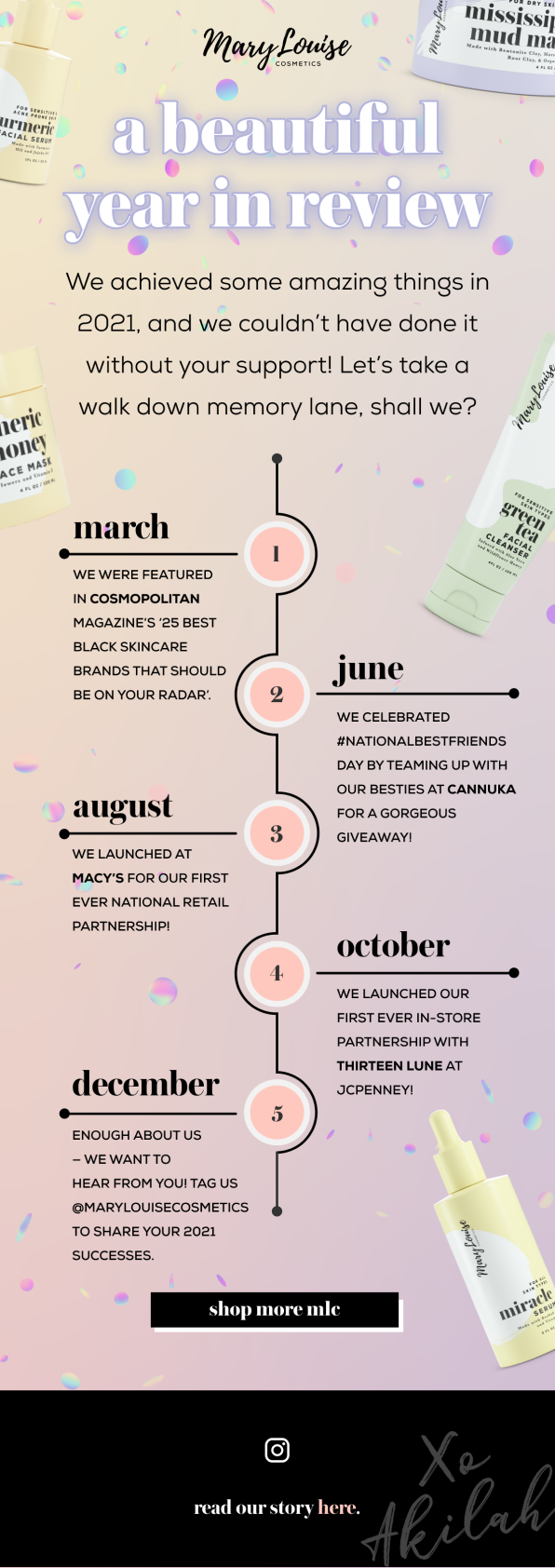


A white-glove service built for success.
We've planned every part of your client experience so you know you're in good hands.
Related Posts

How To Best Use and Understand Klaviyo Flow Filters
As a DTC e-commerce brand, email marketing is one of the most powerful channels to nurture, convert, and retain your customers. But as you grow, customer segmentation becomes an increasingly more important strategy to drive more revenue, higher engagement and more conversions.Enter Klaviyo flow filters.Flow filters might seem like a small, technical feature in learning how to execute email marketing with Klaviyo but they're one of the keys to segmenting your automated flows (along with trigger filters, trigger splits, and conditional splits). Trigger and flow filters act as gatekeepers of your email flows, to allow only the right people to receive the right messages, at the right time.In this guide, you'll learn how Klaviyo flow filters work, ways to use them, and how to set them up for your email flows.What are flow filters in Klaviyo?Flow filters are criteria or conditions you set to determine which email subscribers enter the flow. You can set flow filters based on a variety of conditions such as a customer's location, their purchasing behavior, their engagement with previous emails, or specific characteristics such as their pain points.This allows you to build more customized customer journeys for your email subscribers by having different customers receive different flows.How...

Crafting Engaging Welcome Series Emails: Examples and Templates
30 Second Summary1. 50-75% of the revenue from your Welcome Series typically comes from the first welcome email. So if you do nothing else, focus on doing that right.2. Use the subject line "Welcome to [BRAND]" or "Here's your 10% off code for [BRAND]" to start. Then A/B test.Your Welcome Series is one of the most important automated email flows you can build to set your new e-commerce brand up for success at launch. In fact, if you don't do anything else in email marketing (which we don't recommend!), build your welcome series.Now, you've likely heard that the goal of welcome emails is to introduce or indoctrinate your brand to new email subscribers.But that's not (quite) true.The real goal of a welcome series is to drive your leads to make their first purchase.Done right, a well-crafted Welcome Email Series can accelerate your customers' journey to their first purchase, drastically reducing your cost per acquisition (CPA), bolstering your average dollars per lead and per website visitor, and increasing your average order value (AOV). See why it's one of the most important automated flows you could build?Now, in your research, you've also probably seen lots of inspiration for different welcome emails, been told that "every...

From Zero to Hero: A Complete Guide to Building Your Email List
30 Second Summary1. Your email list is one of the most valuable assets an e-commerce brand can have & building your email list is the first step to effective email marketing.2. Don't make the mistake of building an email list just for the sake of it. You don't just want a list of emails, you want a list of potential customers.3. At a minimum, make sure you have a welcome opt in form, exit intent opt in form, footer signup form, and a sign up form at checkout to capture email subscribers4. Advanced strategies to collect email addresses like lead magnets, quizzes, paid ads, as well as partnerships and giveaways, are other ways to grow your email list5. Regularly clean out your email list, especially for lower-quality leads, and track key metrics such as list growth percentage, unsubscribe percentage, and engagement percentage to measure your success and optimize your email marketingIf you're just getting ready to launch your e-commerce store, or you're new to email marketing, building your email list is an important first step. Your email list is one of the most valuable assets your brand can have to nurture, convert & retain customers to grow your brand.Most e-commerce brands...

How To Use Klaviyo Campaigns
If you're just getting started with email marketing or new to Klaviyo, it's important to get out of the mindset of just sending out email campaigns during promotions or product launches. As an e-commerce brand, you should aim to generate 15-20% of your business revenue from email campaigns.A great email campaign strategy involves creating an effective email marketing calendar, sending campaigns regularly (1-3x per week), and sharing unique email content to build a relationship with customers.Why Klaviyo Campaigns?Campaigns are one-time, targeted emails that are sent to your email list. Mastering Klaviyo campaigns is the first step to learning how to use Klaviyo for email marketing.Klaviyo's drag and drop editor & pre-built email templates make it friendly for beginners. But its extensive A/B testing functionality, segmentation & dynamic content make it incredibly scalable as your business grows.Setting Up Your Klaviyo CampaignThere are a few key elements you'll need to decide on when setting up your Klaviyo campaigns:Campaign name: Choose a descriptive name for your campaign that reflects the topic of the email, the type of content it contains, and makes it easy for you to identify in your dashboards.Recipients: Determine the target audience for your campaign. In Klaviyo, you can choose to select specific segments or lists. Segments...
7 Best Practices For Email Design To Elevate Your Email Marketing
30 Second Summary1. Email design plays a crucial role in the success of DTC e-commerce businesses by capturing attention and compelling action.2. Visual hierarchy guides readers' attention, and scannability enhances engagement.3. Customizing the copy-to-image ratio based on industry, brand, and email type optimizes the impact.4. Strategic CTA placement and clear, compelling button copy increase click-through rates.5. Personalization goes beyond addressing recipients by name and focuses on relevance and meeting individual needs.6. Brand consistency fosters recognition and recall, creating a cohesive brand experience.If you believe that email design is merely about making your emails visually appealing, then you've missed the mark. Email design is the final step in email strategy to drive revenue & convert customers.In this blog post, we will explore the 7 email design best practices to beyond aesthetics & make your emails effective:Visual hierarchyInformation architectureCopy-to-image ratioScannabilityCall-to-action (CTA) placementPersonalizationBrand consistencyGet ready to redefine your approach to email design & master these concepts to create high-converting emails.Anatomy Of An Email: Using An Email LayoutEmail design all starts with the email layout. An email layout is the bones of your email design. Without a strong, high-converting email layout, an email can look beautiful but it won't convert. Think of it kind of like...

Don’t Let Them Get Away: Crafting the Perfect Abandoned Cart Email
With cart abandonment rates averaging around 69% for e-commerce stores, you can't afford to let potential sales slip through the cracks. Abandoned cart emails target these customers who abandon their cart to get them to return to make a purchase. Building an effective abandoned cart email can be quick & easy with the right strategy.By the End of This Blog, You'll:1. Confidently build your first abandoned cart email to convert more customers & drive more revenue2. Understand the core elements that make up an effective abandoned cart email3. Have conversion-optimized abandoned cart email templates to use4. See examples of great abandoned cart emails & subject lines for inspiration5. Have a list of A/B tests to optimize your abandoned cart email strategyOther Resources You May Find Helpful:Our DTC Flow Foundations Guide: This is your ultimate playbook for not just mastering the art of abandoned cart emails, but creating a holistic suite of email flows vital for any DTC e-commerce brand. From welcome series to customer re-engagement strategies, it's all there.Our Free Beginner's Guide To Email Marketing: Starting from scratch? No worries. Our beginner's guide provides you with the A to Z of email marketing. It is tailor-made for e-commerce brands and...

21 Email Marketing Examples to Inspire Your Next Campaign
In the competitive world of DTC e-commerce, a crucial element of customer retention is keeping customers engaged with your brand. Email marketing campaigns are a great way to stay top of mind and relevant to your customers. It's not enough just to send email marketing campaigns about your product. To drive engagement, loyalty, and sales, you need impactful, unique & relevant email campaign topics. That's where an effective email marketing campaign strategy starts.We've put together 21 email marketing examples that are more than just creative inspirations—they're powerful strategies that have driven results for DTC brands. Use these email marketing examples to inspire your next campaign.Use these email campaign examples to generate 3 new campaign ideas to test in the next 60 days!Effective Email Marketing Examples1. Save The Date EmailsSave The Date emails are perfect for creating anticipation for an upcoming promotion or new product launch. The suspense & advanced notice generates more interest, engagement & revenue on launch day. Add in a calendar invite or link to a Facebook event to easily remind interested customers on the day of launch.We tend to see Save The Date emails consistently work for most e-commerce brands, but are particularly explosive for limited edition...

Email Marketing Metrics: Unlocking the Power of Data to Drive Your Campaigns
Whether you're struggling with the intricacies of Klaviyo's built-in reporting, drowning in an ocean of dashboards, or simply seeking ways to turn your data into actionable strategies, you're in the right place. We're here to help you navigate the complexities of email marketing metrics and tap into the wealth of insights they offer.This blog post is for you if:1. You're still using Klaviyo's built-in reporting & don't know how to interpret the data.2. You have a myriad of dashboards filled with email data, but you're not sure what needs your attention.3. You're feeling overwhelmed with your email marketing data and want to focus on what's important.4. You want to turn your data into actionable strategies to enhance performance.Many DTC ecommerce brands, perhaps even yours, fall into the trap of over-investing in data accumulation and under-investing in actioning on it. This blog post is designed to help you break free from this pattern.What you'll learn in this blog post:1. The key email marketing metrics you should be measuring.2. What your email marketing metrics are telling you about your customers & the effectiveness of your strategy.3. How to interpret your email marketing data through benchmarking red/green/yellow.4. How to devise a plan of...

Email Marketing Analytics and Benchmarking: The Key to Unlocking Your Campaign’s Potential
So you've started running email marketing campaigns, but now what? Most DTC brands just collect the data & measure the performance of their email campaigns. But that's not enough.Which email marketing metrics should you look at? How do you analyze your email metrics? What do you do with that data? And how will you actually adjust your strategy to consistently improve your performance over time?It's not what data you have, but how you use the data that will scale your email marketing performance.Meet the principle of Actionable Reporting.Actionable reporting is all about transforming raw data on your email metrics into meaningful, easy-to-understand insights and applying them to actionable next steps in improving your email marketing performance. It's about identifying trends, finding patterns, and flagging opportunities to not only understand what's working but also uncover areas that need improvement.Mastering the art of Actionable Reporting is learning how to turn data into information, information into insights, and insights into strategy.Data --> Information --> Insights --> StrategyThere are 3 key elements to effective Actionable Reporting:Email Marketing Metrics: Collecting the right data is crucial to the start of this process. Email marketing analytics allows you to dive deep into the performance metrics of your campaigns, identifying what works and what...


